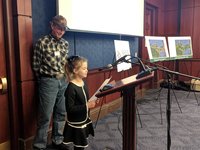Affordable Broadband for Students Hinges on FCC’s EBS Proceeding
Monday, April 29, 2019
Digital Beat
Affordable Broadband for Students Hinges on FCC’s EBS Proceeding

I know firsthand what it’s like living on the wrong side of the digital divide because my local community in rural Minnesota has been experiencing it for far too long. That is one of the reasons why I founded A Better Wireless, a wireless ISP that is seeking to connect rural Minnesotans who lack affordable broadband access.
The most upsetting part about the digital divide is the lack of access our students face. As more teachers assign homework that requires an internet connection, students without home access are at a severe disadvantage. My granddaughter and her third-grade classmates are living in this divide known as the “Homework Gap.” At Battle Lake Independent School District in Otter Tail County, Minnesota – where my granddaughter attends school – 23 percent of all families with an enrolled student lack broadband access. This Homework Gap not only impacts families from participating in digital life but also severely inhibits students from accessing the same educational opportunities that benefit their urban peers.
All communities deserve access to the tools that can help close the digital divide -- especially in communities where the commercial sector is unwilling to deploy broadband. The most critical tool that can help rural communities and their partners bridge this divide is access to wireless spectrum. Despite having access to over 620 MHz of low- and mid-band spectrum suitable for cost-effective, rural broadband deployment, commercial carriers have not been willing to invest in rural Minnesota communities like mine.
Last year, Otter Tail County approached commercial providers asking to help solve our digital divide. Incumbent telephone companies told the county it would take $49 million to expand fiber along roadways in just the southern third of the county. This plan would require rural residents to pay to bury fiber from the road down their driveways—some of which are half a mile long or longer.
A Better Wireless submitted a proposal to connect these same households with fixed wireless for a fraction of that cost. For just $8.6 million, we would upgrade capacity for county schools -- which currently pay $2,300 per month for 200 Mbps service -- to gigabit access for just $750-$1000 per month. For students who ride the bus up to an hour one way to and from school—a journey that takes even longer when we receive 30 inches of snow—we plan to equip school buses with internet access to turn travel time into homework time. And families with enrolled students that qualify for free and reduced lunch plans would get 25/10 Mbps service for just $15/month.
Our plan also includes offering fixed wireless broadband access to every resident in the county for just $45 per month. In addition, we will offer our public safety officials access to a mobile, public safety network.
But our plan hinges on the Federal Communications Commission making currently unused Educational Broadband Service (EBS) spectrum available to educational entities. While EBS has been licensed in roughly half of the United States, geography covering 85 percent of Americans, the remaining half covering roughly 50 million Americans has never been licensed. The FCC has now proposed to finish licensing this spectrum -- which has essentially been frozen since 1995 -- to local educational entities. A Better Wireless has already developed partnerships with schools interested in applying for licenses if the spectrum is made available. We have also joined an advocacy group with 70 other companies and educational entities called Educators and Broadband Providers for American Rural Communities (EBPARC) to help make this proposal a reality. I recently traveled to Washington (DC) to tell the FCC and Congress about the critical need for smaller operators like mine to access this key spectrum band.
The biggest threat to our plan is that large, national, wireless providers are urging the FCC to sell these licenses to them instead of continuing to license to educational entities. Rural schools like those in Otter Tail County will not be able to compete in a spectrum auction against large telecommunications companies—the same companies that have been ignoring our community for far too long. Even if resources were available, schools in some states are not legally allowed to spend resources on spectrum.
For my granddaughter and other students all across Minnesota without home broadband access, the stakes in this FCC proceeding are high. Without access to EBS spectrum, we cannot effectuate the change we need to ensure that every student and resident has access to affordable, high-capacity broadband. If we want our communities to thrive, we all have a stake in closing the digital divide. I encourage everyone to visit SaveEBS.org to learn how you can contact your representatives and the FCC and urge them to finish licensing EBS to help rural communities and students who are being left behind.
Mitchell Koep is CEO of A Better Wireless
Benton, a non-profit, operating foundation, believes that communication policy - rooted in the values of access, equity, and diversity - has the power to deliver new opportunities and strengthen communities to bridge our divides. Our goal is to bring open, affordable, high-capacity broadband to all people in the U.S. to ensure a thriving democracy.
© Benton Foundation 2019. Redistribution of this email publication - both internally and externally - is encouraged if it includes this copyright statement.
For subscribe/unsubscribe info, please email headlinesATbentonDOTorg






